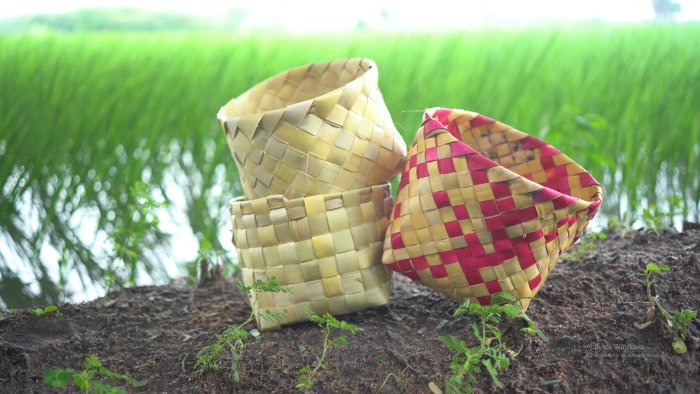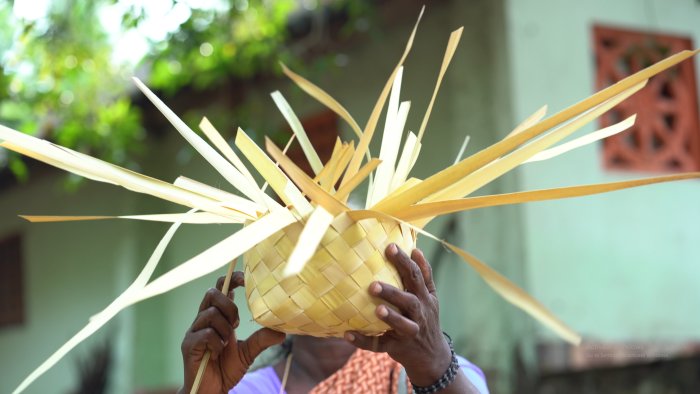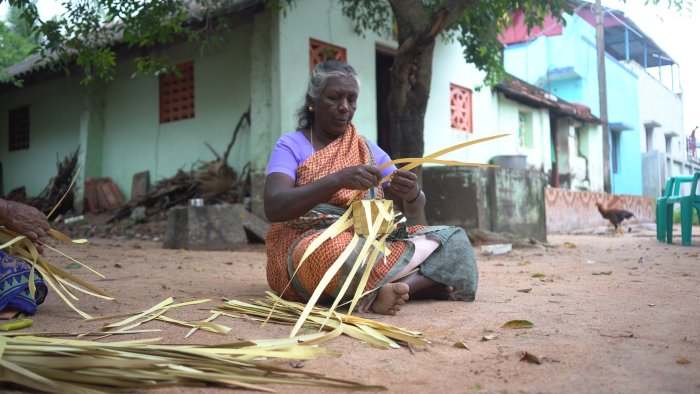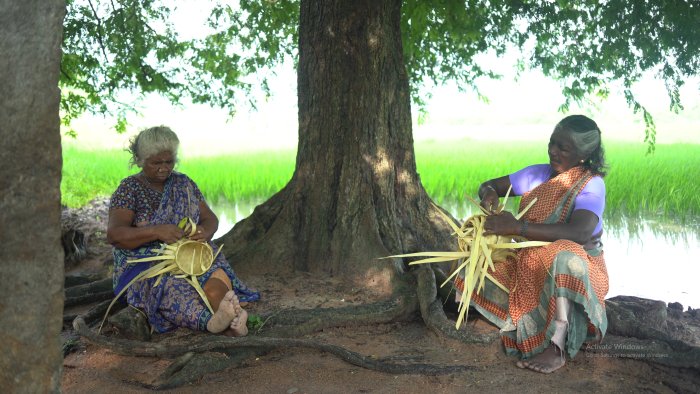CHETTINAD ICSSR PROJECT
Contact: chettinad.icssr@christuniversity.in
Weaving Heritage: The Art of Kottan Making in Chettinad
In Tamil Nadu's culturally rich Chettinad area, a wealthier cultural
heritage of handmade palm-leaf baskets known as Kottans weaves together
heritage, identity, and sustainability. What started as a humble home
industry done by women of the Chettiar community, Kottan craft has
developed beyond its functional origins to become a symbol of Tamil
Nadu's craft heritage. As the world looks for more sustainable and
heritage-based products, the resurgence of Kottan is an interesting
example of how tradition and modernity can meet.
A Glimpse into Chettinad Culture
Chettinad in the Sivaganga district of Tamil Nadu is marked by its
majestic mansions, wood carvings, dazzling tile flooring and
distinctive cuisine. By chance, it is also the birthplace of the
Nattukottai Chettiars, an affluent mercantile community whose roots in
Southeast Asia run very deep. Their love for culture, art and
architecture fashioned a culture within which traditional art forms like
Athangudi tile making, wood carvings, and weaving of Kottan flourished.
Kottan baskets were a daily part of life in Chettiar homes. Initially
they were woven by the women or Aachis of the Chettinad community. They
were stored with betel leaves, grains, jewellery and even given as
gifts at weddings and festivals. The baskets were made by women of the
community, sometimes as a daily domestic activity. As plastic and
factory-made containers became more prevalent, the tradition
disappeared - until a revival effort put it back in the spotlight.
 
What is a Kottan?
A Kottan is a light, compact basket in traditional times made of dried
palmyra leaves (Borassus flabellifer), a South Indian native palm.
"Kottan" is the Tamil word for basket. The baskets were originally in
plain natural colors in traditional times, but bright dyes and complex
weaving patterns became part of the craft later.
They come in all shapes and sizes - round, square, lidded, or open.
Natural dyes or eco-friendly colours are employed by artisans to produce
bright pinks, greens, blues and yellows creating dramatic visual
effects. The palm leaves are cut into thin strips, dyed, dried in the
sun, and then woven by hand into geometric shapes or floral patterns.
The Kottans are mainly used as containers and packaging for gifts and
other materials.
The Process of Making a Kottan
1. Collection of Leaves
The first part is the collection of mature Palmyra leaves. Certain firm and flexible leaves are selected to be woven.
2. Boiling and Drying
Leaves are boiled to remove impurities and to soften the fibers. They are sun dried to dry completely prior to dyeing.
3. Dyeing
Natural or artificial dyes are used to colour the dried palm leaves. The
craftsmen colour the leaves in bright celebratory hues carefully and
dry them again.
4. Splitting and Smoothing
Once dried, the leaves painted on are sliced up into thin, uniform
strips with small knives. They are then softened and flattened so they
don't fray when weaving.
5. Weaving
This is the most expert phase of the process. Artisans apply their bare
hands to intermingle the coloured strips in balanced patterns, slowly
building the basket. It requires hours to days to complete a single
Kottan, depending on the size and intricacy of the Kottan.
 
From Decline to Revival
By the later part of the 20th century, Kottan weaving as a practice had
nearly come to an end, with even fewer women being able to muster the
time and the skills needed to carry out the practice. Through the help
of NGOs, women's self-help groups, and cultural preservationists, the
Kottan weaving has revived as a mode of livelihood besides an exercise
in cultural preservation.
One of the key actors in this revival is the M.Rm.Rm. Foundation, which
hires rural Tamil Nadu artisans to conserve and market traditional
crafts. M.Rm.Rm was formed in the year 2000 by Ms Visalakshi Ramaswamy
with the aim of working towards the revival of crafts that once existed
in the Chettinad region. The foundation trained artisans, held craft
exhibitions, and introduced artisans to urban markets and global
exhibitions. Because of their initiative, Kottan baskets developed a new
identity - not as ordinary household goods but as sustainable, artisanal
lifestyle products. The foundation organises community building and
craft workshops for artisans to groom craft revival, through which it
motivates young minds of the community to finish their schooling.
Researchers, students of craft and architects are welcomed with great
enthusiasm to the foundation to encourage the promotion of crafts in the
Chettinad region and to facilitate discussions with visitors and local
communities. In recognition of the craftsmanship and regional
significance, Kottans were given the Geographical Indication (GI) in
2013 to protect the identity of the craft along with providing
livelihood to the artisans who work tirelessly to preserve the old-age
tradition of Chettinad crafts.
Kottan Today: Blending Tradition and Innovation
Kottans have evolved far from their original application in the contemporary world market. Nowadays, they are utilized as:
Packaging for wedding and festivals
- Decorative items in boutiques and homes
- Environmental substitutes for plastic bags
- Luxury or artisanal product branded packaging
Kottan artisans have partnered with eco-friendly entrepreneurs and
designers to implement fresh shapes, colour schemes, and functional
pieces such as coasters, clutches, and trays. Traditionalism has,
therefore, mingled with current design seamlessly yet without losing
roots.
Alongside, as part of cultural tourism, live workshop and demonstration
of Kottan weaving are also now a part of experiential tourist experience
in Tamil Nadu. The visitors are not merely exposed to the craft but
have the opportunity of interacting with craftsmen directly and hence
creating cultural and economic value for the local community.
Challenges Ahead
Despite its revival, Kottan weaving faces challenges:
- Raw material availability: With fewer palmyra trees in certain locations, it might be challenging to obtain quality leaves.
- Livelihoods of artisans: Most of the youth have other employment options, thus a knowledge gap across generations.
- Market penetration: Although the interest is on the rise,
competition from mass-produced items still constrains the profitability
of the handmade crafts.
These challenges must be met by systemic support - ranging from
government policy and available raw materials for sustainability to
online marketing for worldwide reach.
Preserving a Living Heritage
Kottan weaving is not only a craft; it is a living link to Chettinad's
matrilineal society, sustainable living, and art. In a world moving more
and more towards conscious consumption, the Kottan is an example of how
ancient traditions can be reinterpreted.
Marketing this art brings rural women artisans income and reaffirms
local identity and cultural continuity. Experiential learning, joint
design, and cultural education help the Kottan continue to weave its
place into the tapestry of modern life - one basket at a time.
Kottan and the Indian Knowledge System
Kottan weaving is a fine manifestation of the Indian Knowledge System
(IKS) consisting of traditional practice, indigenous technology, and
community-based craftsmanship transmitted from generation to generation.
Founded on sustainability, self-sufficiency, and nature sensitivity,
the practice is an articulation of the IKS philosophy for the use of
locally available materials such as Palmyra leaves with non-harmful
effects on nature. It also utilizes traditional women's knowledge, oral
knowledge transmission, and communal learning - distinctive aspects of IKS
favoring experiential, holistic knowledge as opposed to book knowledge.
Incorporation of Kottan weaving, cultural tourism, and design
innovation into education curricula preserve a breathtaking craft and
respect the broader Indian epistemology favoring interconnectedness,
heritage and sustainability.
Authors
1. Twinkle Sara Joseph, Research Scholar, Department of Media Studies, Christ University, Bangalore
2. Dr. Balakrishnan C - Associate Professor, Department of Computer Science, Christ University, Bangalore
3. Dr. Biju K C - Professor, Department of Media Studies, Christ University, Bangalore
4. Dr. Anitha Suseelan - Professor & Head, School of Architecture, Christ University, Bangalore
5. Ajith Paul, Research assistant, Department of Computer Science, Christ University, Bangalore
|